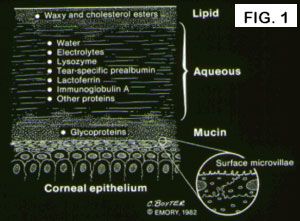Dry Eye Syndrome Dallas Fort Worth
The "dry eye," or keratoconjunctivitis sicca (KCS), is one of the most common ocular conditions affecting patients. It affects 15-20% of the adult population in the U.S. Although usually mild in severity, even minimal dry eye disease can significantly affect patient comfort and ocular health. Despite greater understanding of tear film production, the underlying cause of dry eyes is often unknown. However, various therapeutic modalities are available to give the patient some relief from chronic ocular problems.
What It Is
The preocular tear film acts as an interface between the cornea and the outside environment. There are several important functions of the tear film. First, the tear film provides a smooth, high-quality refractive surface over the cornea providing the individual with sharp, clear vision. Second, our tears serve as a vehicle for oxygenation and nourishment of the corneal surface. Finally, the tear film contains several "natural antibiotics" that protects the ocular surface against infection.
 The preocular tear film is comprised of three distinct layers (See figure 1), each essential to maintaining the health of the eye. Abnormalities of any of these layers can cause a tear dysfunction problem. The innermost layer is made of mucous and is responsible for the "wettability" of the tears. Abnormalities of this layer usually result from prior chemical injuries or rare scarring conditions, such as ocular pemphigoid. The middle layer is composed of aqueous or water produced by the lacrimal gland. Deficiencies of this water layer are the most common cause of a dry eye. This form of dry eye results from idiopathic aqueous phase deficiencies (keratoconjunctivitis sicca or KCS), either alone or with associated systemic immune-mediated disease. Finally, the outer lipid layer, produced by the Meibomian glands, also enhances the stability and coverage of the middle aqueous layer by inhibiting tear film evaporation. A deficiency in any one of these layers can result in a dry eye. Although dry eye syndrome commonly results from an insufficient aqueous layer, it may also result from an abnormal and destabilizing lipid or mucinous layer or from problems in eyelid function and blinking. Finally, the composition of the tears themselves can become unbalanced and lead to inflammation and dry eye symptoms.
The preocular tear film is comprised of three distinct layers (See figure 1), each essential to maintaining the health of the eye. Abnormalities of any of these layers can cause a tear dysfunction problem. The innermost layer is made of mucous and is responsible for the "wettability" of the tears. Abnormalities of this layer usually result from prior chemical injuries or rare scarring conditions, such as ocular pemphigoid. The middle layer is composed of aqueous or water produced by the lacrimal gland. Deficiencies of this water layer are the most common cause of a dry eye. This form of dry eye results from idiopathic aqueous phase deficiencies (keratoconjunctivitis sicca or KCS), either alone or with associated systemic immune-mediated disease. Finally, the outer lipid layer, produced by the Meibomian glands, also enhances the stability and coverage of the middle aqueous layer by inhibiting tear film evaporation. A deficiency in any one of these layers can result in a dry eye. Although dry eye syndrome commonly results from an insufficient aqueous layer, it may also result from an abnormal and destabilizing lipid or mucinous layer or from problems in eyelid function and blinking. Finally, the composition of the tears themselves can become unbalanced and lead to inflammation and dry eye symptoms.
Signs and Symptoms
Ocular irritation is one of the earliest symptoms a patient with KCS may experience. Classically, the patient describes a sandy, gritty, foreign-body sensation, in one or both eyes, that often becomes more pronounced as the day progresses. Some patients may note a more severe "burning" sensation in the eye when exposed to particularly dry or irritating environments, such as dry heat, warm or smoke-filled rooms, and wind. Sensitivity to light may also be reported.
The physician can often detect signs of dry eye during the examination. These findings include decreased corneal luster and marginal tear strip, increased mucous debris and ropy strands in the tear film, and dry spots detected with the biomicroscope. In addition, your physician may perform other diagnostic tests to make the diagnosis and establish the severity of your disease.
Diagnostic Tests:
Vital Dye Stains
Rose Bengal (1%) or lissamine green dye specifically stains both dry and devitalized epithelial cells and mucous. Vital dye stains can thus highlight these abnormal changes in the ocular surface.
Tear Break-up Time (BUT)
The tear break-up time (BUT) is a direct measure of the stability of the preocular tear film. A normal tear film with sufficient lipid, aqueous, and mucinous layers begins to break up, or show signs of discontinuity, after approximately 10 seconds. This process is generally accelerated in patients with KCS.
Schirmer Tear Tests
The Schirmer test is a measurement of tear volume and is performed by placing a strip of litmus paper over the lid margin to collect the amount of tears produced over a period of five minutes. Measurements of tear volume are gross measurements only and are not very sensitive or specific. Nevertheless, they are easily performed, and if abnormal, can be predictive of KCS.
Biochemical Tests
Although biochemical tests are more sensitive and specific than the tests previously mentioned, they are expensive and usually impractical and unnecessary; thus, they are rarely performed.
Treatment of Mild to Moderate Keratoconjunctivitis Sicca
General Considerations
At present, there is no cure for keratoconjunctivitis sicca (KCS); however, there are a number of therapeutic options available to ameliorate the symptoms. In general, patients suffering from KCS will benefit from a moist, humid environment. A warm, dry room can be made more tolerable by using a home humidifier and by avoiding smoke or dust. Goggle-type glasses, swimmer’s goggles, and even side shields with spectacles increase the humidity in the environment immediately around the eye, and delay the evaporation of tears.
Artificial Tear Preparations
Artificial tears remain the primary treatment for mild to moderate keratoconjunctivitis sicca (KCS). Most artificial tears act as lubricants although others aim to replace missing tear constituents or to decrease the solute concentration in the tears. Many are derivatives of cellulose or polyvinyl alcohol; while some replace lipid components of tears.
I. Preserved Tear Preparations
All of the preparations in these categories contain preservatives (detergent or oxidative preservative) and all must be instilled regularly and frequently to compensate for inadequate tear volume or an unstable tear film. A number of tear preparations of each type are available; however, all such preparations have the same drawback: insufficient duration. The patient usually selects the most suitable and least irritating artificial tear by trial and error.
II. Non-Preserved Solutions
One of the big advancements in tear therapy has been the introduction of preservative free preparations. Usually these products are packaged in single dose dispensers that can be used and discarded at the end of the day. Although less convenient than tears in larger bottles, they are appropriate for individuals requiring very frequent instillation of tears (hourly or more frequent) or for patients sensitive to a given preservative.
Ill. Ointments
Ointments offer the advantage of increased viscosity and retention time; however, they have not been found to be uniformly superior to conventional tears, and at times, they may blur vision because of their increased viscosity. They are particularly helpful for use at bedtime or in individuals in whom the disease is more severe.
Cyclosporine: Cyclosporine is an FDA-approved pharmaceutical eye drop that has been shown in clinical studies to reduce the clinical signs of dry eye disease and to improve patients’ symptoms. It works by reducing inflammation and increasing goblet cell density (the cells that produce mucin).
Lifitegrast: Lifitegrast is an FDA-approved pharmaceutical eye drop that has been shown to decrease the clinical signs of dry eyes and improve patient’s symptoms. It also works by a targeted reduction of ocular surface inflammation.
Tear Conservation by Punctal Occlusion: Conserving existing tears by reversible (punctal plugs) or irreversible (punctal cautery) punctal occlusion can be of tremendous benefit to KCS patients with severely deficient aqueous tear volume. Punctal occlusion prolongs the action of artificial as well as natural tears by retaining them longer in the conjunctival cul-de-sac. One method of occlusion is to place a silicone based punctal plug into the tear drainage holes of the lids. The advantage of this type of punctal occlusion is its reversibility. If punctal plugs appear to relieve the symptoms of KCS with few or no problems, then permanent punctal occlusion via cautery may be considered.
Partial or Total Tarsorrhaphy: In severe cases of dry eye it is appropriate to consider partial or total surgical closure of the eyelids. This is known as a tarsorrhaphy. This procedure decreases the surface area that the eye needs to keep lubricated
Serum Tears: In severe cases of dry eye, the patient’s own serum can be drawn and diluted to produce autologous serum tears. These tears contain nutrients and anti-inflammatory components. Serum tears have been shown to be effective in improving both clinical signs and patients’ symptoms of severe dry eye disease.
Contact Lens: Special contact lenses such as the Prosthetic Reconstruction of the Ocular Surface Ecosystem (PROSE) lens and other scleral contact lenses can significantly improve vision, comfort and ocular surface health in some patients who suffer from severe dry eye. The PROSE lens is a custom-made scleral contact lens with a central reservoir that is filled with sterile saline and which constantly bathes the cornea in artificial tears.
Treatment of Meibomian Gland Dysfunction: As many patients with decreased tear production also suffer from chronic blockage of the oil-secreting (Meibomian) glands of the eyelid margin, many are also advised on techniques to improve oil production in these glands. The mainstay of improving these symptoms is often applying warm compresses to the eyelids on a daily basis. If severe chronic obstruction of these glands develops, manual expression with an in-office procedure can help relieve the obstructions and symptoms.
To learn more about dry eye and how it can be treated, please contact us today.


